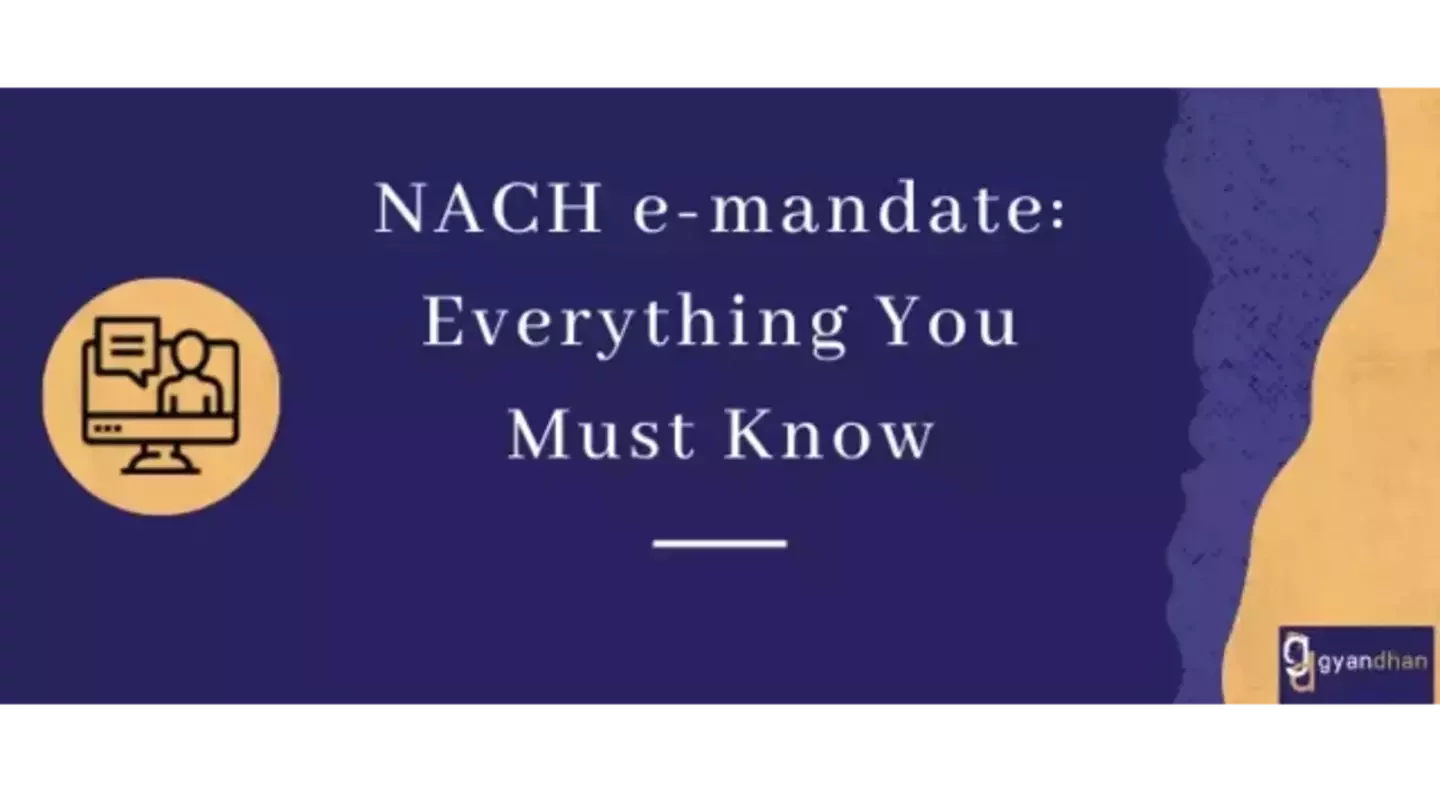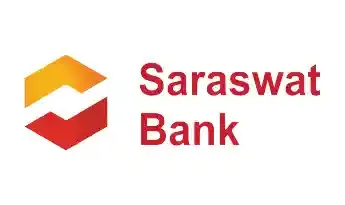Get instant loan offer suitable to your profile !


On this Page:
Read all about NACH e-mandate and how it works. Know the basics of online NACH and how it is different from ECS. Also, understand NACH debit and NACH credit.
NACH or the National Automated Clearing House is a new payment service rolled out by the NPCI (National Payments Corporation of India). The e-NACH or e-Mandate helps businesses in collecting recurring payments and is a boon to the Indian finance sector. With a heavy load on banks, corporations, and financial institutions, the sector needed to get a sustainable and smooth solution to ease the collection of recurring payments.
NACH is very useful for doing bulk transfers like salaries, pensions, subsidies, etc. With the coming of NACH, high volume transfers are much easier now, and even in the case of inter-bank transfers, the system works perfectly.

NACH mandate is an authorization that a consumer provides to a financial institution or corporate body to debit or credit funds. The NACH mandates help in consolidating multiple Electronic Clearing Services (ECS) to enable high and low volume transactions on the NACH e-mandate platform. With a nationwide presence, the NACH mandate is all set to incorporate the entire banking system irrespective of the location of branch location. NACH mandate has seen exponential growth until now, with more than 82,000 core banking allowed bank branches. This has entirely changed the landscape of the bulk recurring payment systems in India.
The ambit of the NACH e-mandate has widened over the years, and now students can also use the platform for recurring payments of the student loan EMI. So, seeing it from a narrow scope of corporate finance solutions might be underrating the platform’s capability.

NACH mandate has smooth functioning, and it works via linking the Aadhar or PAN with the e-NACH. There is no use in going through paperwork that may be a bit clumsy at times in the new system. The new system relies on the transfer of all the relevant data like the details of EMI, Loan, etc. The verification process is entirely online, and there is no physical interface whatsoever. Now we will explain the working in the following steps:
 The process begins with Person X filling the e-mandate form for recurring payments to the corporation/financial institution Y, i.e., the body receiving the money.
The process begins with Person X filling the e-mandate form for recurring payments to the corporation/financial institution Y, i.e., the body receiving the money.
 After filling the form, Person X submits the e-mandate form to corporation/financial institution Y. The details pertaining to the payments/transfer are verified by the money receiving body.
After filling the form, Person X submits the e-mandate form to corporation/financial institution Y. The details pertaining to the payments/transfer are verified by the money receiving body.
 Once the details are verified by Y, the e-mandate form is transferred to the bank with NPCI.
Once the details are verified by Y, the e-mandate form is transferred to the bank with NPCI.
 After the verification process is completed, Y’s bank account is enabled to receive payments from X’s account for recurring payments.
After the verification process is completed, Y’s bank account is enabled to receive payments from X’s account for recurring payments.
 There is a provision for X to cancel the payments at any point in time. However, it is not a blanket rule, and there can be cases where the payment receiving body might have explicitly disallowed the discontinuation of the payments. Some banks and mutual funds don’t allow the cancellation of recurring payments.
There is a provision for X to cancel the payments at any point in time. However, it is not a blanket rule, and there can be cases where the payment receiving body might have explicitly disallowed the discontinuation of the payments. Some banks and mutual funds don’t allow the cancellation of recurring payments.
Check Your Education Loan Eligibility

NACH Credit: NACH credit is a system within the e-mandate that helps in doing high-volume credits into beneficiary accounts. The credit system is used to do transfers related to subsidies, dividends, interests, wages, etc. Corporations and financial institutions use the NACH credit with low or high volume transactions.
NACH Debit: It is used for taking in deposits by banks and other financial institutions to collect both low and high-volume recurring payments. The NACH debit platform has eased the process of deducting monthly expenses like EMI, School fees, Mutual Funds, etc.

NACH has wholly revamped the recurring payment architecture in India, and now the ease with which bulk transfers are made is truly spectacular. The cost of fund transfer, the amount of paperwork, clerical costs, and a ton of unwanted expenses are zero. The cost of maintaining the platform and payment architecture is way less than the amount the government and banks used to spend on the physical model. The offline transfer mode was not only costly in terms of the direct operational cost but rather it was reflected more in the loss incurred due to the loss of valuable time.
However, the NACH mandate has genuinely revolutionized the bulk recurring transfers, and here are the benefits of e-mandate:
 The nationwide presence of the NACH e-mandate (over 82,000 bank branches) makes it the best platform for low/high volume fund transfers.
The nationwide presence of the NACH e-mandate (over 82,000 bank branches) makes it the best platform for low/high volume fund transfers.
 The nationwide presence of the NACH e-mandate ensures that the debit operations are done within a day.
The nationwide presence of the NACH e-mandate ensures that the debit operations are done within a day.
 The platform has a smooth auto-pay deduction mechanism that doesn’t need any manual intervention at the regular interval in the payment cycle.
The platform has a smooth auto-pay deduction mechanism that doesn’t need any manual intervention at the regular interval in the payment cycle.
 A simple interface of the platform makes it user-friendly for everyone, and one doesn’t need to have some sort of extra technical expertise to handle the transfers.
A simple interface of the platform makes it user-friendly for everyone, and one doesn’t need to have some sort of extra technical expertise to handle the transfers.
 The platform is equally compatible with banks, corporates, government bodies, etc.
The platform is equally compatible with banks, corporates, government bodies, etc.
 The operational cost of the platform is very much feasible compared with the ease that it has brought to the country’s financial system.
The operational cost of the platform is very much feasible compared with the ease that it has brought to the country’s financial system.

There has been a misconception that NACH is solely restricted to easing the operations of corporates and finance bigwigs. But NACH has a considerable role to play in the life of a commoner. One of the long-faced problems for the working class is that they weren’t able to get their salaries on bank holidays. Companies usually transfer all the salaries in one day, and this wasn’t possible with the earlier system, but now with NACH e-mandate, it is possible. RBI has announced that from 1st August 2021, NACH transactions will be available on all days.
Another benefit for a commoner is the deduction of EMIs, SIP, etc., on a monthly basis. Earlier, one had to remember all the dates for specific payments, but now, with NACH e-mandate, the deductions are made automatically. The only thing one needs to take care of is to have sufficient funds in the account. The auto-debit facility of NACH ensures smooth monthly recurring payments without any manual intervention at the end of the customer or the money receiving body.
In the case of monthly EMIs, there were instances when the day of deduction used to be a public holiday, and the money was deducted the next day despite having money in the bank account. But this will not be the case anymore since the EMI deduction will take place on all the days independent of a bank holiday. So, NACH will ease the lives of a commoner by ensuring smooth payments and no delays in salary days because of a public holiday. With NACHs nationwide presence, the system has become so efficient that most of the bulk payment doing and receiving entities are using the platform to ease the lives of a commoner with minimal operational cost.
Check Your Education Loan Eligibility

ECS or the Electronic Clearing System used to be the preferred platform for regular and periodic fund transfer. But there were many limitations with ECS, which considerably slowed the speed of bulk transactions. The cost of operation was also high, and on top of it, the method was not so secure. NACH is the new solution for the age-old problem, and it is developed by taking insights from the regulator like RBI to leading banks of India.
ECS had a limited reach, and it was available at only 89 centers. Out of the total, 15 were maintained by the RBI, while commercial banks maintained the rest. On the other hand, NACH is operational at more than 82,000 banks branched across the length and breadth of the country.
| ECS | NACH |
|---|---|
|
No standard working model, local barriers were causing delays. |
A standard procedure, it will consolidate all the ECS. No delays. |
|
The settlement took 3-4 Days |
Same-day settlement |
|
The dispute mechanism was run by a designated and sponsor bank. |
A dedicated body deals with the dispute mechanism. All the process is electronic and online . |
|
Physical mandate verification delayed the process and was unsecured. |
Mandate Management System, with a standard mandate format. |
|
No provision for a unique mandate registration reference number. |
Unique mandate registration reference number. |
|
Rejections are more in number when compared with NACH |
Rejection only on accounts of minor errors; overall rejections are less. |
Read Also:
NACH e-mandate is yet another endeavor by the government to make the digital payment structure more robust. The cost of maintaining the system is always less than the overall loss a bank or a corporation may incur on account of human delays. There are several spheres where digitization has eased people’s lives, and NACH e-mandate helps ease the lives of a considerable chunk of people, financial institutions, and corporations.
NACH is a more sustainable system than earlier systems of bulk payments like ECS. The inclusion of India’s leading banks in the NACH steering committee makes it more inclusive than other prevailing systems. It also represents the mandate of the organizations that its work will impact. So, an inclusive system like NACH is undoubtedly one of the most significant financial sector reforms. It has eased the payment ecosystem in India that is all set to incorporate the massive volume of digital transactions that people will do in the years to come.
Check Your Education Loan Eligibility

Ask from a community of 10K+ peers, alumni and experts
Trending Blogs
Similar Blogs

Network with a community of curious students, just like you
Join our community to make connections, find answers and future roommates.. Join our CommunityCountry-Wise Loans
Best Lenders for Education Loan

ICICI Bank

Axis Bank

Union Bank

Prodigy

Auxilo

Credila

IDFC

InCred

MPower

Avanse

SBI

BOB

Poonawalla

Saraswat